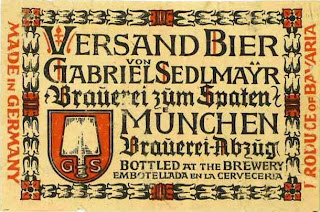
"Gentlemen, you all know the beautiful gift of God that is called Salvatorbier; this beer is brewed by the joint-stock company Schmederer that is the fortunate owner of the Zacherlbrauerei in Munich. This company has recently submitted the trademark "Original Salvator" to the Reich Patent Office, has obtained a registration, and the objections of a whole number of other breweries, who also brew Salvatorbier, were ignored, yes, it has gone so far that the district court in Munich passed an injunction and seized the beer stocks of the other brewers and has started criminal proceedings against the directors of these breweries. Now, everyone who understands the brewing industry knows that the name Salvatorbier in no way implies origin from a specific brewery, but, just like Bockbier, is only a certain type of beer, a stronger type of beer, that is a specific sort. It's certainly reasonable for the Zacherl brewery to call its beer Zacherl-Bräu Salvator; but if officials allow a single brewery to register the name Original-Salvator, if courts punish those who use the designation and seize their stocks, it shows how little expertise the courts possess, and how necessary it is to protect them from such indefinite terms, as those found in the critical words of § l.
Gentlemen, I have information from another brewery in Munich, in which it is shown that in the year 1896 212 Munich publicans obtained their Salvator supplies from the Schwabinger Salvator-brewery, and that in the same year the Zacherlbrauerei only supplied 44 publicans with its Salvator. I have also here a very interesting list of about 30 breweries, which brew Salvator, not only in Munich but also elsewhere in Germany. There are, for instance, the following breweries, which for many years have brewed Salvatorbier and sold under that name: the Hellbrauerei in Passau since 1840, Schmeroldsche the brewery in Passau for 40 years, the Gablersche Brauerei in Nuremberg for 40 years, SSanderbrauerei in Würzburg for 15 years, the brewery of Gebrüder Geismann in Fürth for 12 years, Forsters Dampfbrauerei in Schwabach for 6 years, Pröl Ungers-Brauerei in Schwabach for 6 years, Kaiserslauterner Aktienbrauerei since 1874, SalvatorbrauereiSchrabing in Munich (formerly Petuel) since 1878, the Kronenbrauerei in Augsburg, the Spatenbrauerei, Hackerbrauerei, Thomasbrauerei, Bergbrauerei in Munich, Frankenbrauerei in Bamberg, the Brauerei von Roas in Neuburg near Passau, Gebrüder Lederer in Nuremberg, Evora in Fürth, Aktienbrauerei Meißner Felsenkeüer in Meißen, the Deiningersche Brauerei in Hof, Aachener Exportbrauerei, die Freiherrlich Sternburgsche Brauerei in Leipzig, the Brauerei von F. D. Benders Söhne in Kaiserslautern, the Anklamer Bergschloßbrauerei in Nienstedten, the Modische Brauerei in Lindenhoff etc. All these and many other breweries market a strong beer with the name "Salvatorbier", - and now comes the Zacherlbrauerei, which once, when there were still Zwangs- und Bannrechte, got permission from the Bavarian government to call a particular beer Salvator to call it - the word originally meant Sankt-Vater-Bier - and demands with administrative help a monopoly over a certain beer type. This can happen because the authorities have so little technical insight."
"Die Bekämpfung des unlauteren Wettbewerbs" by Adolf Lobe, 1907, pages 372-374
Nothying new under the sun, is there? The reaction of other brewers was to think up other names with the suffix -ator. WHich is why we have such great names as Triumphator, Bajuvato, Bambergator, Terminator, etc. So I guess Zacherl's shady dealings were neither that successful nor totally bad for the drinker.


















































































































